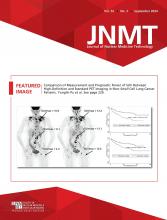Visual Abstract
Abstract
Fibroblast activation protein is a promising target for oncologic molecular imaging with radiolabeled fibroblast activation protein inhibitors (FAPI) in a large variety of cancers. However, there are yet no published recommendations on how to set up an optimal imaging protocol for FAPI PET/CT. It is important to optimize the acquisition duration and strive toward an acquisition that is sufficiently short while simultaneously providing sufficient image quality to ensure a reliable diagnosis. The aim of this study was to evaluate the feasibility of reducing the acquisition duration of [68Ga]FAPI-46 imaging while maintaining satisfactory image quality, with certainty that the radiologist’s ability to make a clinical diagnosis would not be affected. Methods: [68Ga]FAPI-46 PET/CT imaging was performed on 10 patients scheduled for surgical resection of suspected pancreatic cancer, 60 min after administration of 3.6 ± 0.2 MBq/kg. The acquisition time was 4 min/bed position, and the raw PET data were statistically truncated and reconstructed to represent images with an acquisition duration of 1, 2, and 3 min/bed position, additional to the reference images of 4 min/bed position. Four image quality criteria that focused on the ability to distinguish specific anatomic details, as well as perceived image noise and overall image quality, were scored on a 4-point Likert scale and analyzed with mixed-effects ordinal logistic regression. Results: A trend toward increasing image quality scores with increasing acquisition duration was observed for all criteria. For the overall image quality, there was no significant difference between 3 and 4 min/bed position, whereas 1 and 2 min/bed position were rated significantly (P < 0.05) lower than 4 min/bed position. For the other criteria, all images with a reduced acquisition duration were rated significantly inferior to images obtained at 4 min/bed position. Conclusion: The acquisition duration can be reduced from 4 to 3 min/bed position while maintaining satisfactory image quality. Reducing the acquisition duration to 2 min/bed position or lower is not recommended since it results in inferior-quality images so noisy that clinical interpretation is significantly disrupted.
Footnotes
Published online Apr. 16, 2024.
This article requires a subscription to view the full text. If you have a subscription you may use the login form below to view the article. Access to this article can also be purchased.
SNMMI members
Login to the site using your SNMMI member credentials
Individuals
Login as an individual user








